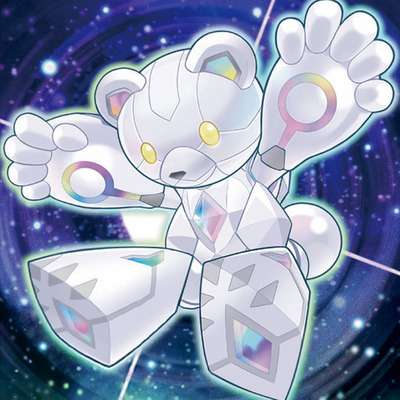Welcome back to the Comprehensive Companion to Cardians - A long form guide and introduction to the flower cardians as an archetype, from what the cards themselves do down to decklists and tech options available for the strategy.
I'm Brexx, an individual crazy enough to take this deck to regionals in zoodiac format, and I'll continue as your guide on this journey into the Hanafuda archetype. Today I'll be introducing and covering the Flower Cardian synchro lineup to round out the monsters before we explore the supporting spells and traps in Part 3.
The Synchros
The flower cardian synchro lineup features a total of four monsters at time of writing. All of these monsters are best summoned using the level modulation effects of flower cardian tuner monsters such as Flower Cardian Peony with Butterfly due to them requiring many monsters as material and their levels being multiples of two of their number of required materials. Due to this, it's unlikely you'll see these monsters in other strategies due to their strict summoning requirements.
All of these monsters are based on yaku (combos) in Koi-Koi, a game played with hanafuda cards, and all of them total levels with which the corresponding hanafuda combo cards can be used to synchro summon them.
Level six
At level six, our first two Flower Cardian synchro monsters enter as the easier to summon of the bunch. Requiring three monsters including one tuner, these monsters are often summoned as part of your combo lines, and help to further extend your plays or prevent your opponent from retaliating on their turn.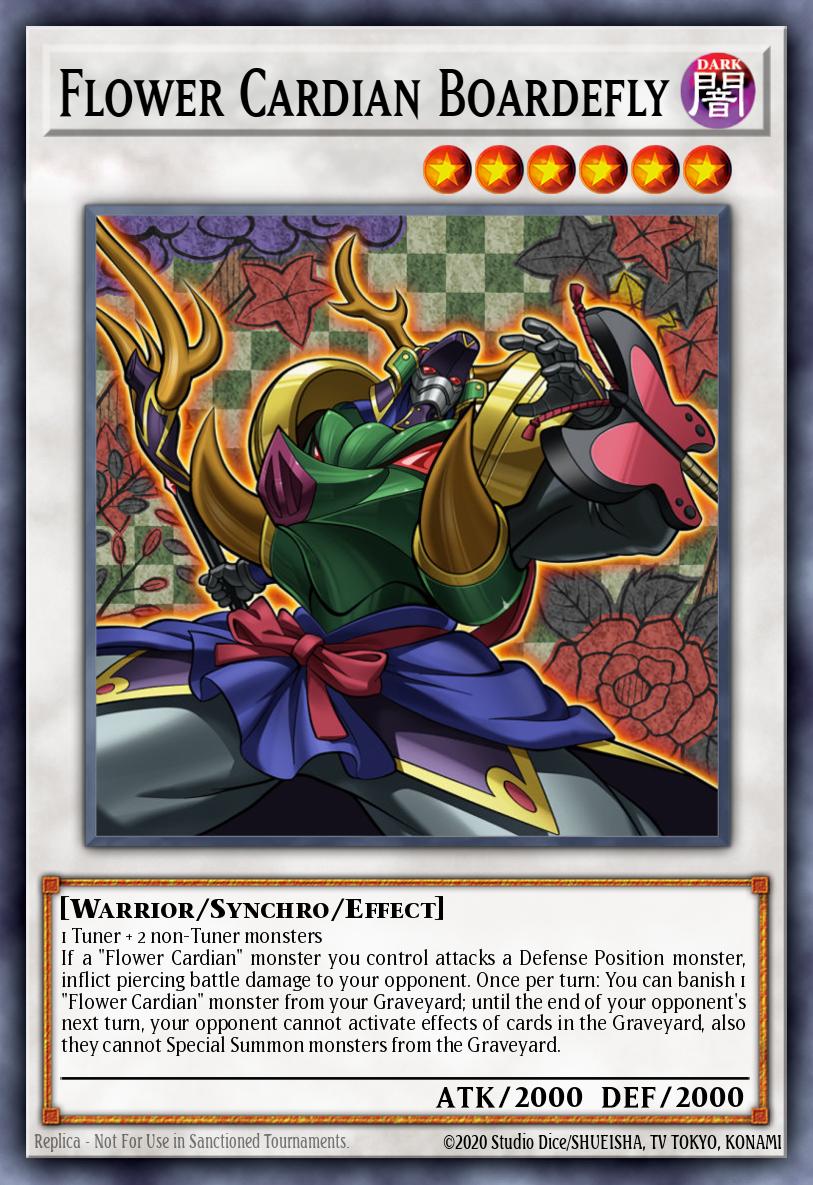
Our first synchro is Flower Cardian Boardefly. As the portmanteaued name might suggest, this card represents a combination of the boar (Flower Cardian Clover with Boar), deer (Flower Cardian Maple with Deer) and butterfly ( Flower Cardian Peony with Butterfly) cards in Hanafuda.
First off, this card gives blanket piercing to all Flower Cardian monsters you control. While this is niche due to being a battle focused effect, this can quickly rack up damage when used in conjunction with our other synchro monsters with exponentially larger attack point values. Worth keeping in mind that this is an option for killing opponents who wall up quickly, but this isn't the reason this monster is played.
Secondly, Flower Cardian Boardefly allows you to banish one flower cardian monster from your graveyard in order to prevent your opponent from activating effects in the graveyard or summoning from the graveyard until the end of their next turn. In essence, this is a stronger variant of Abyss Dweller, and lingers similarly once resolved, meaning this monster can be tributed or used as synchro material once you have resolved its potent effect. Definitely consider which cardian you'll want to banish, as you'll want to keep copies of Flower Cardian Willow in circulation, and should opt to banish normal summonable monsters once you no longer have need for them or your worse extenders once they have been used.
Overall Flower Cardian Boardefly is a strong synchro monster, and you'll likely see one or two copies in any Flower Cardian decklist worth their salt. Through Flower Cardian Willow you'll have ample opportunity to recycle this, so don't be too concerned about running out of copies. 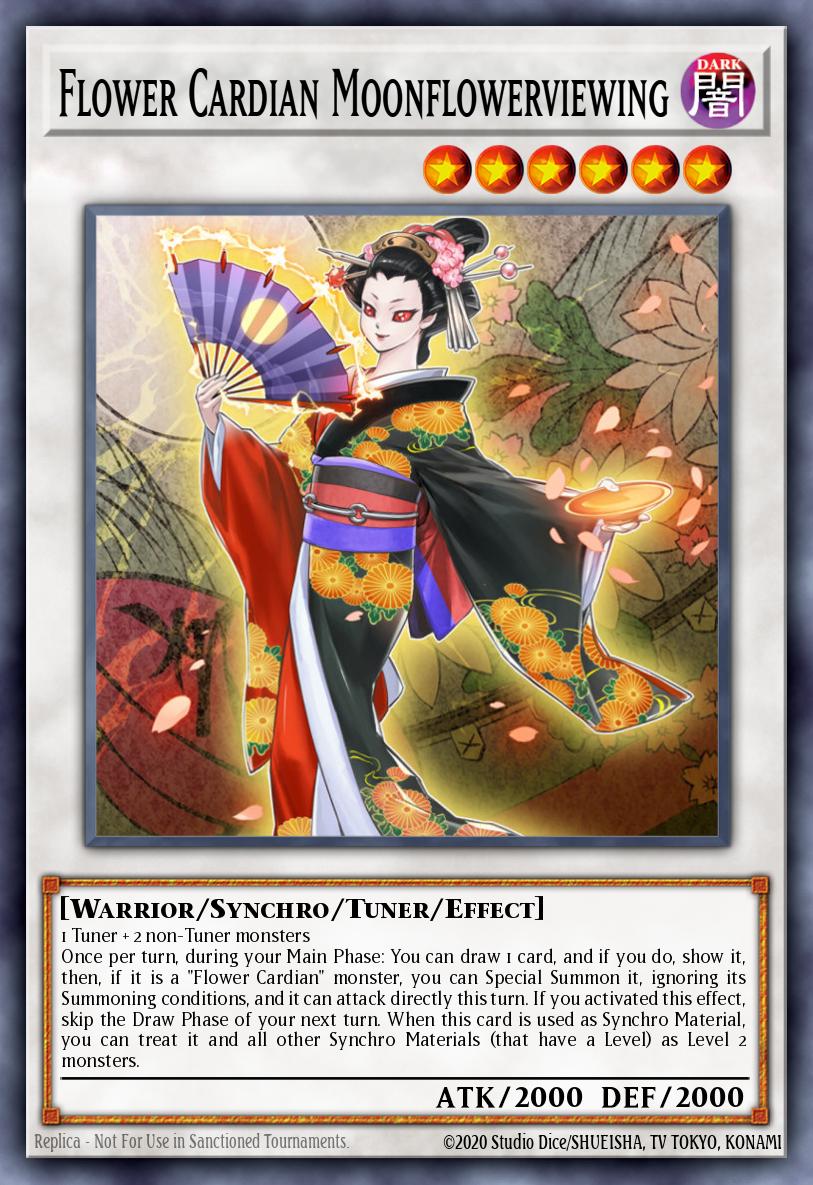
Our second level six synchro is Flower Cardian Moonflowerviewing. This card took a long time to hit the TCG, being released originally in the OCG's Dimension Box set, not being released until almost three years later in 2018's Flames of Destruction. Like Flower Cardian Boardefly, Flower Cardian Moonflowerviewing requires one tuner and two non-tuner monsters as material. Similarly, you'll likely be making this using any three flower cardian monsters utilising the level modulation effects of the flower cardian tuner monsters.
Flower Cardian Moonflowerviewing's first effect allows you to draw a card, reveal it, and then special summon it if the monster drawn is a Flower Cardian monster. Unlike other effects of its ilk, Flower Cardian Moonflowerviewing ignores summoning conditions, allowing you to special summon other flower cardian monsters that normally cannot be summoned outside of their own effects. Additionally, this effect doesn't force you to discard the card drawn if the card drawn isn't a flower cardian monster. Lastly, this effect is once per turn per copy of the card, which can quickly get out of hand.
Moonflowerviewing is notably also the only flower cardian synchro monster that is also a tuner at time of writing, and shares the same level modulation effect present on the deck's main deck tuners.
This card is a lynchpin of almost all variants of flower cardian decks. Run three at all times. You'll often use more than three copies during a combo.
In hanafuda, this card represents two paired card combinations: The Moon (Flower Cardian Zebra Grass with Moon) with Sake Cup (No yugioh card at time of writing) and Sakura Curtain (Flower Cardian Cherry Blossom with Curtain) and Sake Cup. One day we'll get Sake cup...
Level Eight
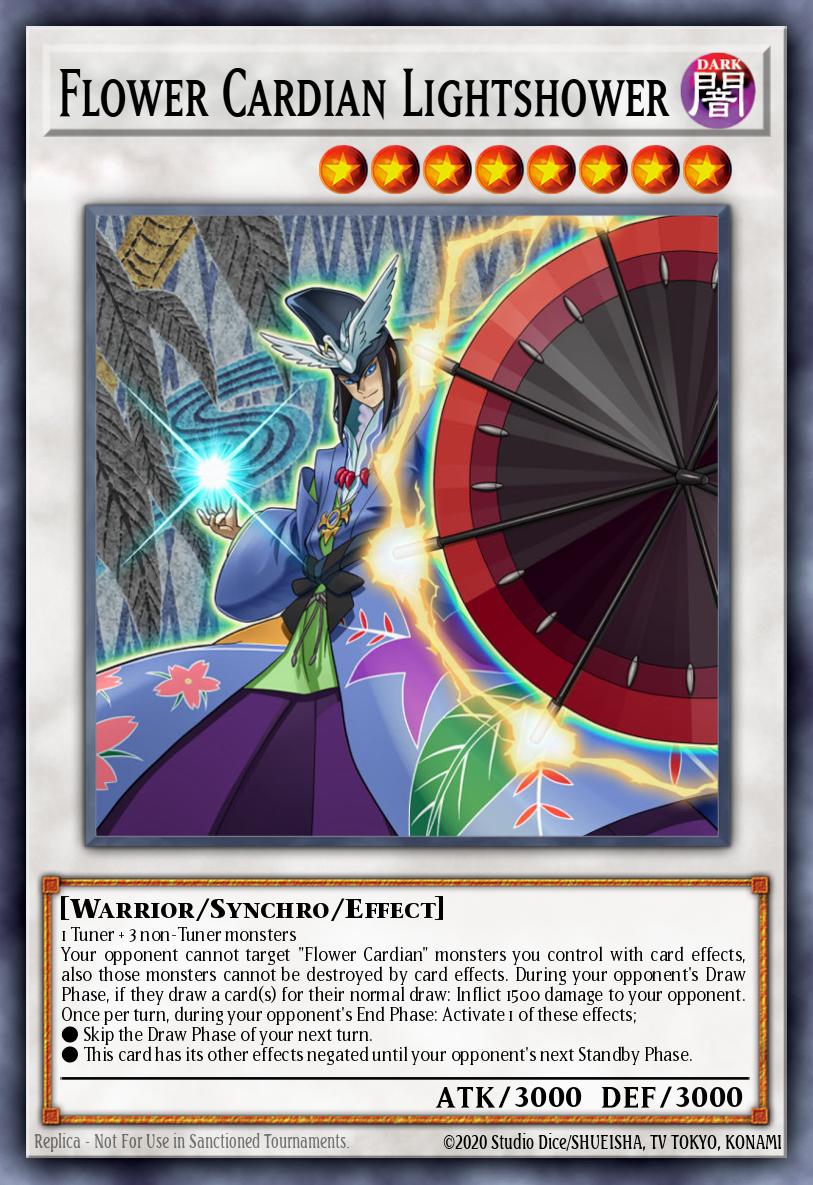 Enter: Flower Cardian Lightshower. This synchro monster was introduced in the first wave of Flower Cardian monsters, and remains a staple of the deck's strategy. Like the previously mentioned synchro monsters, the intent is to summon this card using four level two monsters, or through utilising the Flower Cardian tuner modulation effect to use any four flower cardian monsters including the tuner as synchro material.
Enter: Flower Cardian Lightshower. This synchro monster was introduced in the first wave of Flower Cardian monsters, and remains a staple of the deck's strategy. Like the previously mentioned synchro monsters, the intent is to summon this card using four level two monsters, or through utilising the Flower Cardian tuner modulation effect to use any four flower cardian monsters including the tuner as synchro material.
Flower Cardian Lightshower has several effects, but most importantly he protects all of your flower cardians from being targeted or destroyed by card effects. An important note is that this also applies to your own effects, which will matter more once we cover some of the effects in the archetype's spell cards. This effect makes cardian monsters quite hard to remove, but this effect definitely feels dated when compared to modern removal cards such as Evenly Matched or powerful monster effect board wipes such as Divine Arsenal AA-ZEUS - Sky Thunder.
Secondly, Flower Cardian Lightshower inflicts 1500 damage to your opponent when they draw during their draw phase. Notably this effect isn't a hard once per turn, and as such if you have three copies of this card on the field (which is extremely doable in the archetype) your opponent will be taking 4500 damage per turn unless they manage to remove them from the board.
Lastly, during your opponents end phase, you must choose to either skip your next draw phase, or negate this card's effects until your opponent's next standby phase. Amusingly, the vast majority of the time you will opt to skip your draw phase, as resolving the effect of Flower Cardian Moonflowerviewing means you would be doing so anyway, and skipping your draw phase becomes necessary in longer duels with this archetype due to the risk of decking out that comes with drawing as many cards as the archetype does.
In Hanafuda, this card represents the "Ame-Shikō" card combination, which comprises of any four hanafuda cards including Ono No Michikaze (Flower Cardian Willow with Calligrapher).
You'll likely run three of this card, but at minimum two. Usually you'll summon at least one in every combo, unless you particularly want to push for the burn effect to be relevant, but you may want one extra as our next boss monster can summon a copy of this card when he is removed from the board in most scenarios.
Level Ten
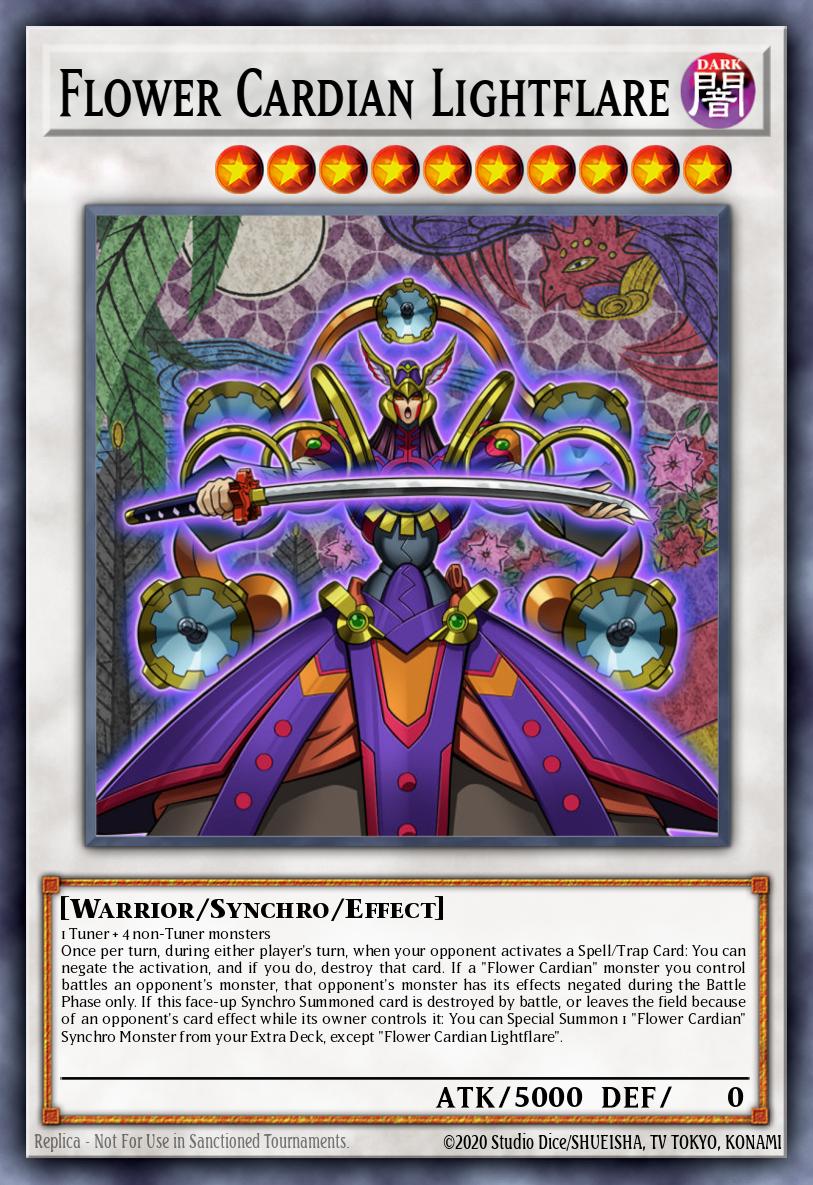 Lastly, we have Flower Cardian Lightflare. Lightflare serves as the deck's primary boss monster, and is by far the theme's hardest monster to summon. In previous iterations of yugioh's master rules, it was impossible to summon multiple copies of this card without revival effects due to the summoning requirement requiring five monsters including a tuner, but with the addition of Flower Cardian Moonflowerviewing and the addition of extra monster zones it's now possible to summon at least two copies before running out of zones to summon more monsters.
Lastly, we have Flower Cardian Lightflare. Lightflare serves as the deck's primary boss monster, and is by far the theme's hardest monster to summon. In previous iterations of yugioh's master rules, it was impossible to summon multiple copies of this card without revival effects due to the summoning requirement requiring five monsters including a tuner, but with the addition of Flower Cardian Moonflowerviewing and the addition of extra monster zones it's now possible to summon at least two copies before running out of zones to summon more monsters.
Requiring five monsters to summon, you'll typically summon this utilising four flower cardians and one flower cardian tuner monster, and are unlikely to see this card utilised outside of this archetype due to this.
Flower Cardian Lightflare features the only negation effect present in the archetype, allowing you to once per turn negate a spell or trap activation at no cost, and also boasts by far the largest attack value of any flower cardian monster. In combination with Flower Cardian Boardefly, this card can deal some devastating piercing damage in a pinch. Additionally, Flower Cardian Lightflare negates the effects of any monster that battles a flower cardian monster for that battle phase. At time of release, this was particuarly important as it allowed the theme to have immunity to cards such as Number S39: Utopia the Lightning, which typically would be used to remove large monsters without risk of backrow to prevent it.
Lastly, Flower Cardian Lightflare leaves the field by battle (not too likely) or by an opponent's card effect (far more likely), you can summon any other flower cardian synchro monster from your extra deck. Typically, this effect will give you an extra copy of Flower Cardian Lightshower, as it is the largest attack and defensive body, and the other flower cardian monsters don't do a whole lot in your opponent's turn.
Flower Cardian Lightflare is based on the Goko card combination in hanafuda, which is a five card combination utilising all five 20-point hanafuda cards, represented by the flower cardian monsters who have 2000 attack points.
Next time - We'll be covering the Flower Cardian spell and trap lineup, to round out the theme's cards. Stay tuned!
